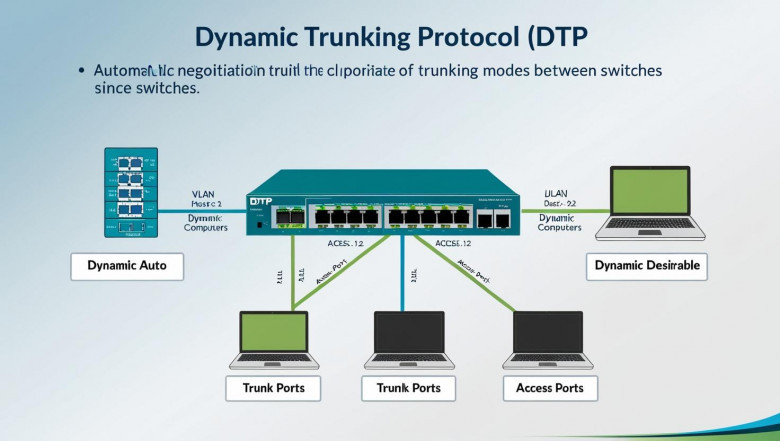views
Dynamic Trunking Protocol vs Static Trunking: Which to Utilize?
In today's enterprise networks, switching and VLAN configurations are basic tenets that any network engineer should have a firm grasp of. Among them, trunking is essential to enable various VLANs to communicate between switches. However, when deciding to configure trunk ports, two main options are DTP (Dynamic Trunking Protocol) and Static Trunking.
And so, which one do you pick — Static Trunking or DTP? In this UniNets blog, we compare the differences, advantages, and practical uses of both approaches. On our way, we shall also cover significant networking issues such as the difference between switching and routing, VRF in networking, computer network MCQ, as well as network security concepts for use in certifications such as CCNA and CISSP training.

What Is Trunking in Switching?
Before comparing DTP and Static Trunking, let’s understand trunking itself.
In a switched network, trunk ports are used to carry traffic for multiple VLANs between switches. This allows devices in different VLANs but connected to different switches to communicate with each other through a single link.
Dynamic Trunking Protocol (DTP): A Quick Overview
Dynamic Trunking Protocol (DTP) is Cisco's own protocol for automatically negotiating trunk links between two Cisco switches. Dynamic Trunking Protocol makes VLAN configurations easier and minimizes errors caused by human intervention.
There are some DTP modes:
Dynamic Auto: Will be a trunk if the other end initiates it.
Dynamic Desirable: Actually attempts to create a trunk on the other end.
Trunk: Compels the port to be a trunk.
Access: Compels the port to be an access port.
Static Trunking: A Manual Method
Static Trunking requires manually setting up trunk ports at both ends of the link. This technique offers greater control and security, particularly in production environments where dynamic negotiation can cause misconfigurations or unwanted access.
DTP vs Static Trunking: Major Differences
Here's how the two methods compare:
Automation: DTP automates the trunk negotiation process, while static trunking involves manual configuration.
Security: Static trunking is more secure because DTP can be used against some scenarios.
Flexibility: DTP is convenient for lab setups or where lots of changes take place.
Stability: Static trunking guarantees stable behavior and prevents negotiation breakdowns.
Real-World Use Cases
In the labs at UniNets, we train professionals and students through real-world labs where both DTP and static trunking are set up and tested.
In enterprise networks, static trunking is commonly used because it is reliable and secure.
In test environments or training labs, DTP can time-save and ease configurations.
Trunking and Switching vs. Routing
Learning trunking cannot be complete without the knowledge of switching vs. routing.
Switching is at Layer 2 (Data Link Layer) and is tasked with data forwarding within a local area network (LAN).
Routing is at Layer 3 (Network Layer) and is employed to forward packets from one network to another based on IP addresses.
Trunking is a part of the switching functionality and has nothing to do with routing, yet both cooperate in providing end-to-end connectivity between VLANs and subnets.
MCQs Based on DTP and Trunking (For Exam Prep)
If you are preparing for exams such as CCNA, CISSP course, or computer MCQ practice, these sample networking MCQs may assist you.
Q1: Which DTP mode actively initiates trunk negotiation?
A. Dynamic Auto
B. Dynamic Desirable
C. Access
D. Static
Answer: B
Q2: What is the danger of deploying DTP in a production network?
A. High resource usage
B. Security flaw
C. Sluggish performance
D. No VLAN support
Answer: B
These computer network MCQs are frequently asked during exams and interviews, and students of UniNets must know them.
DTP and VRF Networking: Can They Coexist?
In more sophisticated network configurations, technologies such as Virtual Routing and Forwarding (VRF) are implemented along with VLANs and trunking.
So, what is virtual routing and forwarding?
VRF permits several routing tables on one router that are essentially isolated from one another, segmenting the network traffic. It's normally applied in multi-tenant networks or MPLS networks to keep different paths for various customers or departments separate.
Even though VRF and DTP work at different layers (Layer 3 vs Layer 2), they can coexist. For instance, the trunk port on a switch is able to carry traffic for several VLANs, each associated with a different VRF instance on a connected router.
Security Implications: CISSP Training Perspective
From a network security or CISSP training viewpoint, DTP presents possible vulnerabilities. An attacker might attach a malicious device and initiate DTP negotiation frames to compel the switch to become a trunk, accessing more than one VLAN.
To avoid this:
Turn off DTP using switchport nonegotiate on trunk ports.
Implement static trunking and access control lists (ACLs) to secure traffic.
Put unused ports in an unused VLAN and shut them down.
These are key points discussed in the CISSP course modules on network security.
UniNets Training: Mastering DTP, VRF, and Security
Our training sessions at UniNets feature practical labs and MCQs for areas like:
Dynamic Trunking Protocol
Static VLAN setup
VRF network routing
Switching versus routing
CISSP certification training
Our labs mimic actual enterprise environments, readying students for certification exams and interview rounds.
Employ Dynamic Trunking Protocol in labs, test environments, or situations where automatic trunk negotiation is needed.
Employ Static Trunking in production networks where security, predictability, and performance are paramount.
If security and reliability are your concern—consider them paramount in most networks in the real world—static trunking is the solution of choice.
Conclusion
Understanding the nuances of Dynamic Trunking Protocol vs Static Trunking is crucial for any networking professional. Whether you're preparing for a CISSP course, working through computer MCQs, or configuring VRF in networking, trunking concepts will follow you throughout your career.
Ready to expand your knowledge? Sign up with UniNets now to receive hands-on training, guidance on certification, and a network of thousands of practice networking MCQs. Let's construct your network career—one trunk port at a time.










